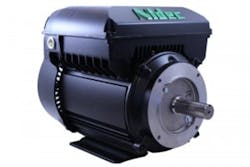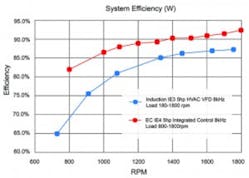When young people are learning to drive a car, they are not taught to drive with a foot on the brake. Instead, they find it is smarter and more efficient to use the gas pedal to vary a car’s speed.
Controlling the flow of water into pools and hydronic heating and cooling systems is similar. Rather than rely on valves to regulate constant flow, today’s more efficient systems depend on pumps with variable speed to vary the flow entering the system.
During the past decade, in fact, as many as 50 percent of all pool and small hydronic pump systems have been upgraded with variable frequency drives or with efficient electronically commuted (EC) motors. EC motors are electric motors that have brushless permanent magnets and have been integrated with a tuned variable frequency motor drive. Because they use electronics to control the voltage and current applied to the motor, EC motors do not waste power inducing the rotor field like induction or other motor types.
Until recently, however, EC motor-driven pumps have only been available in sizes of 3 horsepower or less. Thanks to advances in materials and electronics, these pumps are also now available in an increasing number of sizes and power outputs. Making the switch to EC motor-driven pumps is an easy and economical way to improve the overall energy efficiency of a commercial or light industrial pump system.
"Smart" pump capabilities further boost efficiency
Motors and drives are being integrated to create systems that are smaller, lighter and more efficient.
Pump systems that currently depend on induction motors are among the biggest energy efficiency winners when upgrading to EC motor-driven pumps. It is not only variable speed control that contributes to the efficiency improvements either.
New EC motor-driven pumps entering the market further boost efficiency through their broader functionality, including the ability to communicate with other systems and use information learned to control the pump. These new "smart" pumps are being designed to interface with other industrial electronic devices through the Modbus RTU protocol. They allow users to obtain accurate process control information that they can use to guide decision making. By determining the optimal pressure and flow settings and then applying them to a pumping system, a user can maximize overall system efficiency.
These EC motor-driven pumps are also now available in an increasing number of sizes and power outputs. Some of today’s most advanced integrated EC motor and drive systems can operate at up to 10 horsepower (hp) and meet or exceed the International Electrotechnical Commission-defined IE4 Super Premium efficiency rating. That makes them good candidates for those who want to capitalize on energy rebate opportunities as well.
Even though the industry is most likely still many years away from mandating these super premium efficiency pumps, some manufacturers and their customers are choosing to migrate to EC motor- driven pump systems, in large part because of the high efficiencies and the quicker return on investment they achieve. These pumps not only save energy, but they also can be used to create systems housed in smaller and lighter packages. In fact, switching to physically smaller EC motor-driven pumps can free up space, so features can be added to the end product that make it even smarter and more reliable, while also improving its performance.
Specific advantages include:
shaft currents.
Figure 1. Advanced EC motor-driven pumps with IE4 efficiency ratings and tuned VFD experience less efficiency loss at low speeds than traditional induction pumps.
Easier system installation and integration — When a motor and drive are packaged together, they are easier to integrate into a pump system. In some cases, costs and lead time can be minimizedbecause cabling between the pump and separate control are unnecessary. An integrated drive and pump package also avoids complex setup that standalone VFD pumps typically require.
New standards for comparing pump system efficiency
The new EC motor-driven pumps are more efficient than traditional alternatives. Just how much more efficient, however, has been difficult to measure. Until recently, a user or original equipment manufacturer would have to compare all the individual parts — pumps, drives and other system components — one by one. No national standards are available to follow, so one evaluation might focus on a pump’s efficiency at full-speed, with no consideration of its efficiency at slower speeds or the impact that a drive might have on overall performance. When compared to other evaluations, the results often offered little value.
That is changing now. The U.S. Department of Energy (DOE) is working with an association of industry groups, energy organizations and utilities to improve overall system efficiency, including minimum efficiency requirements for pumps. At the end of 2015, the DOE issued its final rule for pump efficiency. [See "Q&A: What to know about the new DOE Pump Energy Efficiency Rule.”] That rule included new standards for measuring efficiency, including the Pump Efficiency Index (PEI), a new regulation that provides common standards that can be used to compare and evaluate system components against new stricter efficiency standards.
In addition, the new rule provides the standards needed to evaluate "extended products," such as a pump and a motor or a pump, motor and drive control, at multiple points along an efficiency curve. These added standards make comparing one system’s efficiency directly against another’s possible. Because the system measures total possible efficiency, a system with a high performance drive or a flatter efficiency curve can receive a higher PEI rating than one that depends on only an efficient pump.
More, larger "smart" VFD pumps coming
New efficiency requirements are driving the development of larger EC motor-driven pumps, including those containing integrated motors and drives. Pump manufacturers continue expanding the power outputs and other capabilities of these efficient, smart pump systems, as well as the applications in which they can serve.
It is likely a smarter, more efficient pump will be available in the near future. Virtually every industry with process controls will eventually benefit as new efficiency regulations take hold and more efficient pumps become available. The new systems will consume less energy, saving end users money and improving overall industry performance.
Tim Albers is director of marketing and product management for Nidec Corporation. He may be contacted at [email protected].




